Some commands and training practices really aren't necessary€¦but boy, are they nice.
By Dave Carty
I was at a spaniel hunt test years ago when one of the contestants was called to the line.
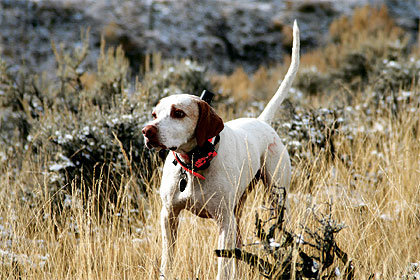 If you get the chance, hunting over a completely steady dog--one that holds point through the flush and shot--is an experience that should not be missed. |
What followed was remarkable because, rather than being heeled in on a short lead, the dog carried the neatly folded leash ever so softly in his mouth. At the line, his owner raised a single finger and the dog sat right down and waited patiently while the leash was taken from him. I was suitably impressed. Recalling that day, I still am.
But holding a leash is hardly a necessity for a field trialer, much less a hunter. What impresses me most about hunting dogs--pointers, spaniels and retrievers--is how well they do what they've been bred to do, not necessarily how well they've been trained. The first reflects on the dog, the second on the owner--and how well that owner knows his stuff.
Few would argue that training a dog to carry his own leash is a necessity, but plenty of other commands aren't so cut and dried. Should you teach your pointing dog to back?
How about slogging through the not inconsiderable amount of time it takes to steady him to wing and shot? Your answer to those questions will vary somewhat depending upon whether you're a field trialer who also hunts or a hunter who sometimes field trials. Just so you know where I'm coming from, I'm firmly in the latter camp. In fact, my field trialing experience is skimpy at best. Hunting over dogs has been and always will be my first love.
These days, I train my own dogs to do just about everything I can think of, but I certainly wasn't always that way, although now and then I'd get real lucky and a dog would essentially train itself. As a puppy, Scarlet, the in-betweener of my three dogs, was backing other dogs before she actually began pointing wild birds on her own. If another dog stopped to poop, Scarlet backed.
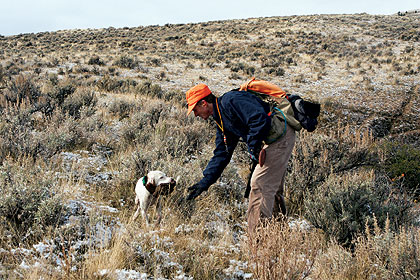 Most hunters probably won't object to a dog breaking point to retrieve a downed bird. |
She backed dogs that stopped to sniff a leaf or check out the view, sometimes from 200 yards away. She's been as faithful to her self-imposed mandate as snow to December and green grass to rain, and in five years she's never once wavered. Although I had absolutely nothing to do with it, she makes me look exceedingly good and I've shamelessly taken credit for her "training." Scarlet doesn't care about my perfidy; she's a dog.
Powder, the oldest of the three, is also an instinctive backer, but unlike Scarlet, has occasional doubts about her commitment to the cause. That requires some touch-up work on my part, but one or two light corrections and she's good for another month.
But the gravy train had to come to an end sooner or later, and with my youngest dog, two-year-old Hanna, the train ran off the rails. Hanna not only doesn't back naturally; she has, as near as I can tell, no interest at all in ever learning to do so. I was faced with a dilemma: should I teach her to back or let it slide?
If I were more of a field trialer, that decision would be a slam-dunk. Many horseback and NSTRA trials require, or at least add extra points, to dogs that back another dog's points.
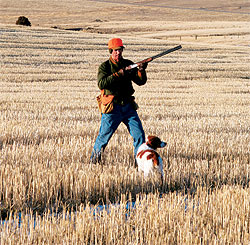 The occasional refresher course on etiquette afield is almost inevitable. |
I've also hunted with men--several, in fact--who get bent out of shape if someone else's dog steals their dog's point. (Oddly enough, some of them don't seem to mind when their dog is the point snatcher, but that's neither here nor there.) Me? I don't care (okay, sometimes I don't care). I look at my partner's point-stealing dog as steadiness reinforcement for my dogs, another nonessential command I'll talk about in a moment.
But I'm dodging the question here. Should a finished dog back? The answer to that is an unqualified yes. But at the risk of sounding too much like a politician, the bigger question is whether you want, or really need, a truly finished dog.
When you read columns by glib writers like me, it's easy to get the impression that finished dogs--whoa, come, back, retrieve, heel, sit, steady, the whole nine yards--are the norm, as though all hunters aspire to the same lofty standards. Nothing could be further from the truth.
I've hunted with serious field trialers who have trained their dogs to the nth degree--an eye-opening experience I'd recommend to anyone who hasn't already done it--but the first meat and potatoes hunting dog I hunted over who was actually steady to wing and shot€¦was mine. Maybe that's a reflection of the kind of low-rent characters I associate with, but I've felt right at home now for an awful lot of years.
Nine times out of 10, you don't need a completely steady pointer any more than you need a pointer that backs. Sure, there are some advantages. A dog that is at least steady to flush is undoubtedly safer than a dog that breaks after a low-flying bird, particularly if there's an inexperienced gunner in your group. And a dog that backs won't rush past a dog who has already established point, possibly putting the covey into the air and forcing you to manufacture a cute answer to explain your dog's antisocial behavior. That, at least, is what I offer up when someone presses me for a rationale.
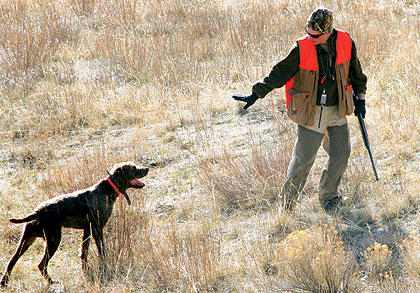 It's always a good idea to take advantage of any opportunity to reinforce a command in the field. |
But the truth is that the vast majority of bird hunters in this country don't steady their dogs and don't teach them to back and they do just fine. A great many of them are friends of mine, hard-core bird hunters and long-time dog owners. To the extent that I enjoy hunting over any dogs other than my own, I enjoy hunting over theirs. Nor do I worry about their dogs
"corrupting" my dog's training. If my dogs break because so and so's dog breaks--and sometimes they do--it underlines the weaknesses in my training program, not theirs.
And yet I continue to steady my dogs, school them in backing and train them to kennel and sit on command, as well as some other stuff that is arguably unnecessary. Here's why: when you've spent hours and weeks and months getting a dog where you want it, and the glorious day arrives when you realize your pup has finally arrived€¦man, it's hard to go back.
Keeping a dog on top of his game takes work, which will come as no surprise to anyone who has ever been there. Dogs don't just carry what they've learned in the yard into the field; in fact, they almost never carry what they've learned in the yard into the field.
Because I like to think I'm actually getting better at this, Hanna, my youngest, was as well trained as any dog I've owned by the end of last summer, but it took me almost two months of reinforcement during the hunting season before the lessons she knew but willfully ignored finally sank in. And as for my darling but headstrong little Scarlet€¦after three years of reliable, bedrock steadiness, the stubborn little squirt decided last season, apropos of nothing, that she was going to chase birds again. I finally brought her back around, but believe me it was painful for both of us.
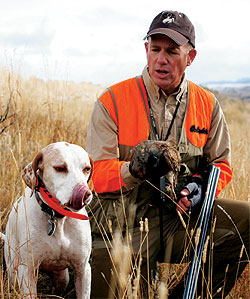 Keeping a dog steady and making the shot can be mutually exclusive concepts. |
My list of nonnegotiable, must-have commands for pointing dogs is so breathtakingly concise that even I can remember it: whoa and come. Train a dog to get just these two--and I mean really get them--and you'll have a dog that is better trained than the dogs owned by 90 percent of the bird hunters in the country.
The essential/nonessential dichotomy extends to training theory as well. Here's one I'll bet you've heard: should you shoot a bird your dog doesn't point? Training dogma is adamant about this, and the answer from on high is an emphatic no.
But the older I get, the less I worry about it. Let's say you're walking here and your dog is over there. You kick up a bird. Do you shoot? I do, unless instructed by the dog's owner not to do so. Or let's just say the dog is upwind of a covey and blunders through and the birds go up, the dog briefly giving chase. Should you shoot? This one's a bit iffy, but there's still a good chance I would, unless asked not to do so.
I like shooting as much as the next guy, but since I hunt 70 to 80 days in a typical year, it's not like I need to kill any more birds. If that lone infraction--and it's a big "if"--does predispose a young pointing dog to busting birds, more work on the whoa command will solve the problem. The truth is, inexperienced dogs are going to bust birds, and I've never found that taking an occasional shot does much to influence the dog's wayward behavior one way or another. I will also admit, however, that I'm in the minority on this.
There are plenty of examples of theories that just don't hold up when rubber meets the road. Should you hunt your dog into the wind? Of course you should. But how often does the terrain lend itself to that? I've seen otherwise rational people get absolutely neurotic about heeling their dogs in a quarter-mile circle so they can work in downwind of a covey that, in a straight line, is only 150 yards away. Sure, if I can do it without too much trouble, I'll bring my dogs in from downwind€¦but sooner or later, every pointing dog has to learn how to work scent downwind, upwind and sideways. Why not now?
Backcasting, which is what happens when your dog hunts behind you instead of in front of you, is another one. A dog may well find as many birds behind as in front, something my dogs prove to me--as if I needed additional evidence--every season on my yearly trip to the damp and grousy bogs of northern Wisconsin. But here I'm going to side with the mainstream: as far as backcasting goes, I don't much care for it. In fact, it annoys me to no end and is number two or three on my list of Carty's Pet Peeves Concerning Bird Dogs. (Whew! For once I don't have to play devil's advocate.)
Instead, I teach my dogs to work to the front, something I apparently haven't been doing particularly well because none of the three are particularly good at it, by whistling or motioning them forward whenever they fall behind. If I have to tell them twice, they get a nick on their collar. Is hunting to the front essential for finding birds? Nope. Nice? You betcha. And sometimes, it's the nice stuff you remember.






